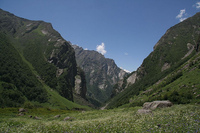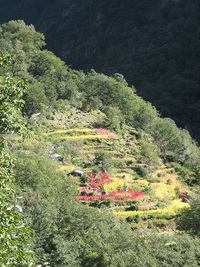 The Valley of Flowers lies in the main Valley of Alaknanda and Dhauli Ganga in the Zanskar range of Garhwal Himalayas in Chamoli District of Uttarakhand. This region of about 88 sq km is notified as a National Park and UNESCO World Heritage Site.
The Valley of Flowers lies in the main Valley of Alaknanda and Dhauli Ganga in the Zanskar range of Garhwal Himalayas in Chamoli District of Uttarakhand. This region of about 88 sq km is notified as a National Park and UNESCO World Heritage Site.
The valley is conspicuous by the presence of crystal clear water of river Pushpavati meandering gently through small and big boulders touching the floral studed banks after originating from Tipra Glacier seated at the base of Gauri Parvat. The valley is situated at an altitude of 3500 to 3733 meters above mean sea level along the central axis of Himalayas and comprises of vast tracts of mountains and snowy peaks. The main feature of the valley is that it is linear in shape (nearly U or cone) of about 5km long and 0.5-2km wide forming the upper catchment of Bhyundhar Ganga, which drains into the Alaknanda at Govindghat. This valley lies in an area of excellent himalayan landscape with the well known mountain peaks of Trishul, Dunagiri, Kamet, Nilgiri Parbat, Rataban and Snow Col, which are about 7000 m. The forests lie mainly below the valley upto an altitude of 3500 meters above which extensive meadows are variegated in summer by a profusion of alpine flora that includes the blue poppy and cobra lilly. The region also hosts several endagered medicinal plants, animals (including the Asiatic black bear, snow leopard and brown bear) and restricted-range bird species.
The most frequented and convenient approach is after crossing the bridge over Alaknanda river at Govindghat (170 km upstream from Srinagar) and trek 14 km upto the base camp at Ghangaria. There is a Forest Rest House at this place and one can find place to pitch the tent amidst Arisaemas and other flowers dotting here and there. The valley is approachable through a pleasant walk through the galaxies of flowers. There are two more approaches which are preferred by shepherds and mountaineers. The one on the western side leads to Hanumanchatti on Badrinath road negotiating through Kunt Khal Glacier pass and the other on eastern side traverses to Ghansali after crossing Lakshman pass. Both these places are of 3 days trekking distance from the valley. 
Among the earliest botanical collectors who visited this area are Strachey and Winterbottom during 1846-1849. The original herbarium of these two botanist included over 2000 species and was distributed to many museums and herbariums in 1852-53. This list was revised by Duthie in 1906, who incorporated in it the results of the previous and the subsequent botanical explorations in the area.
During the three following years, Holdsworth and Smythe, who were members of British Kamet expedition of 1931, on their return journey collected plants in the Bhyundhar Valley (old name). In his book on the Valley of Flowers, Smythe started with, “the story of four happy months spent amidst some of the noblest and most beautiful mountains of the world”. Smythe returned to the valley in 1937, for collecting bulbs and seeds for the Royle Botanical Gardens, Edinburgh. During which period he collected more than 250 species. A list of the plants collected by him during this period is included in this book “Valley of Flowers (1947)”. In this book, he remarks
The Bhyundhar valley was the most beautiful valley that any of us had seen. We camped in for two days and we remembered it as the Valley of Flowers…
It was my privilage to undertake this work and the reader, while remembering, and I hope generously, my ignorance, must judge for himself whether the Bhyundhar valley deserves its title the Valley of Flowers. Others will visit it, analyse it and probe it but, whatever their opinions, to me it will remain the Valley of Flowers, a valley of peace and perfect beauty where the spirit may find repose.
In 1939 the Royal Botanical Garden, Kew’s representative, Ms Joan Margaret Legge, while collecting plants and seeds from the slopes of the valley lost her life. The epitaph on Miss Legge’s grave reads, “I will lift up mine eyes unto the hills from whence cometh my help”.
The monsoon rains usually commence in June and last till the latter half of September. This is the time when the flowers are in full bloom. The best time to visit is the valley is, therefore, from July to August, after the first monsoon rain. Snow usually falls by the middle of September-October and extends sometimes to early April making the valley inaccessible. The reserve of the flowering plants of the valley remain burried in snow up to May and it starts thawing from the beginning of June.
The weather of the valley is uncertain. Mornings of summer months are clear with presence of towering clouds at places against brilliant blue sky. Hail storms feature during autum and spring. Precipitation is received both in the form of snow and rain. The significant features of the climate are long cold winters, deep snow, low mean temperature, and daily fluctuations of temperature.
To prevent excessive intervention in the reserve, access to the valley is controlled and limited to daylight hours and camping is prohibited.

